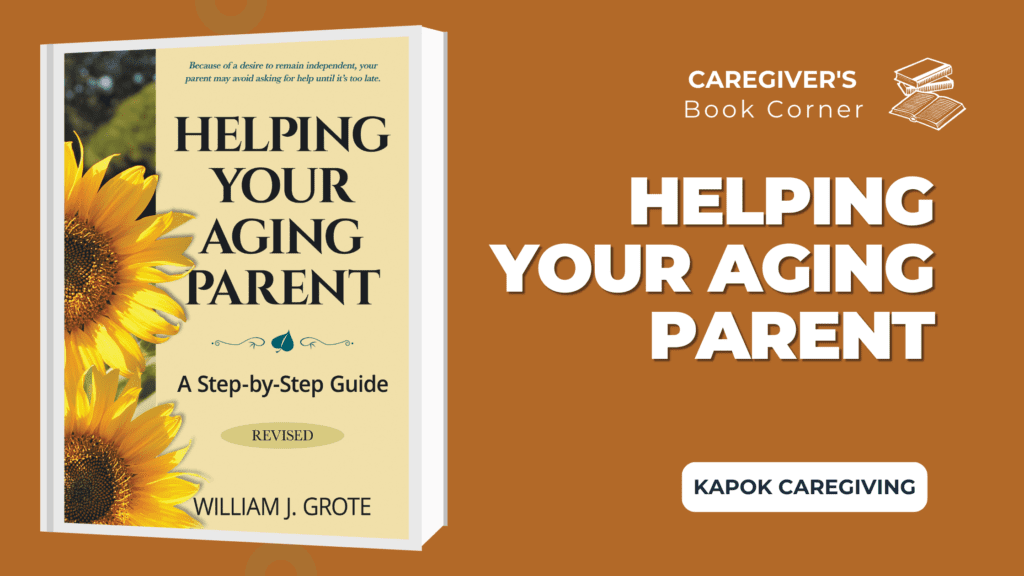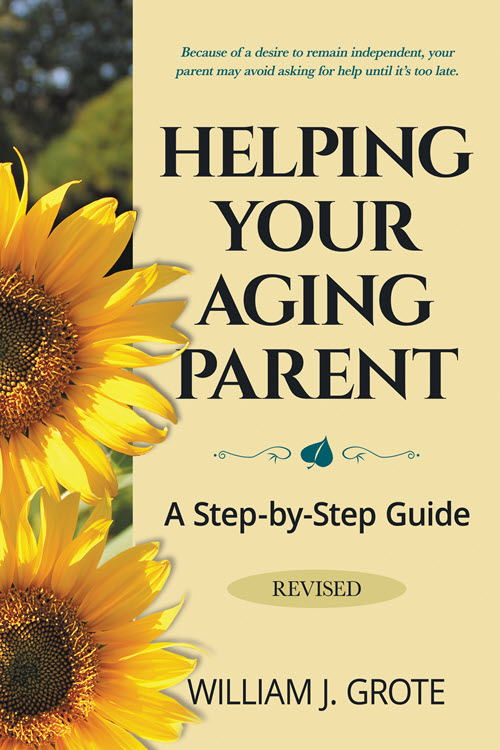
Helping Your Aging Parent: A Step-By-Step Guide is a little different from the other books we’ve reviewed at Kapok, as it isn’t nearly well-known and doesn’t have the same following as other caregiving books.
That’s not a reason to ignore the book, though. After all, many good authors with important things to tell struggle to get their writing noticed. There’s just too much competition. Some of the best books are those that hardly anyone knows about. Those are the incredibly valuable gems, hidden in plain sight.
With that in mind, let us present this Helping Your Aging Parent review. In it, we’re taking a close look at the book, how it might help, and whether there are any limitations to consider.
After all, your time is precious. Even finding the time to read a single book might be difficult, so you want to make sure the book you choose is worth the time investment.
What Helping Your Aging Parent Offers
As the full title suggests, this book does aim to step readers through the challenges and decisions that come with supporting an aging parent. It acts as a guide to many of the complexities you’ll face as a loved one ages, including ones you may not have considered before.
To do so, the book is broken into chapters that progressively address the challenges you might face. These chapters are as follows:
- Chapter 1: Does Your Aging Parent Need Your Help?
- Chapter 2: The Doctor Visit
- Chapter 3: Signing Up For The Future
- Chapter 4: Housing Options
- Chapter 5: Surviving the Hospital
- Chapter 6: Nursing Homes
- Chapter 7: Dealing With Dementia
- Chapter 8: Hospice, Death, And End-Of-Life Care
As you can see, the book follows a progressive style. It starts with the early issues and decisions that you might face, then moves on from there, focusing on progressively more difficult and complicated issues.
There are also subtopics within each chapter, covering all the important areas. For example, Chapter 4 highlights six different options for housing, including a senior apartment, board and home care, and moving your parent in with you. Chapter 6 carries on aspects of this theme by talking specifically about nursing homes, including what they do, their cost, and how to select one.
This style is helpful, as caregiving journeys often follow a similar path. The structure of the book also helps you to think about the issues as they arise and get a sense of the journey that might be ahead of you.
You could also jump around based on what you need. For example, if you’re debating whether a loved one should move to a care facility, you might go straight to the housing options section. Other people may turn to the section on dementia instead.
Each chapter delves into the specific challenges of the topic, interwoven with personal stories from the author, talking about his own journey in supporting his mother. This style of writing works well, giving you real-life and deeply personal examples of what caring for an aging parent can look like.
A Real Life Story
The author of Helping Your Aging Parents has considerable experience supporting his aging mother, which provides plenty of authority to the book.
It’s also helpful to hear the story of another person, rather than a collection of dry facts.
There’s another benefit too. Because the author is talking about his own experience and the challenges his mother went through, readers get to learn about the emotional impacts of the different situations, along with regrets he had and how things played out.
All of this is incredibly helpful information.
It’s also a good reminder that we all get it wrong sometimes. Even with the best intentions and considerable planning, every caregiver makes a few bad calls. It’s impossible not to – as you never have all the information at hand and can’t know how your decisions will play out a year or five down the track.
For example, in the chapter on surviving the hospital, William Grote talks about issues with adverse events and many of the things that can go wrong in a hospital environment.
Such issues often aren’t obvious until they happen – at which time you need to deal with the consequences. Understanding the potential problems can help you to keep your parent safe.
Where The Book Shines
Easy to Read
Some caregiving books are information-dense and packed with academic jargon. While they provide important information, they’re often difficult to read. Helping Your Aging Parent is very different. It uses a conversational style instead, which makes it easy to read.
In places, it feels like having a conversation with a friend, rather than getting advice from an expert.
The personal anecdotes also stop the difficult information from being too overwhelming, while the advice is often gentle and easy to put into place.
Covers Important Topics
Helping Your Aging Parent does cover crucial topics. Most of them will apply to every family at some point or another.
It’s fantastic to have all this information in a single book. The writing style also helps to highlight transitions, such as showing the small changes that may occur from early doctor’s visits to when a parent needs to be moved to a care facility.
The main exception is dementia, as many seniors won’t ever be diagnosed with dementia. Still, the chapter is easy to skip if it isn’t relevant to you.
Personally, I love seeing some dementia details included in a general book about aging parents. William Grote’s details and discussion on the topic may even be enough to get you thinking about your own parent’s behavior in a way that you wouldn’t have before. After all, as William himself mentions, it’s easy to miss some of the signs of dementia or interpret them as something else.
Offers Checklists and Worksheets
Helping Your Aging Parent isn’t just an information-focused book. It also contains a variety of checklists and worksheets, which help you to use the knowledge practically.
For example, the Nursing Home Evaluation Checklist asks questions about the facility type, the environment, the cost, activities, and the like. You could make copies of this checklist and use one for each nursing home. Doing so then gives you a way of easily comparing different nursing homes.
Plus, it’s well-known that many of us don’t take information in well when we just read it. Doing something with that information, like filling out a worksheet is much more powerful than just reading.
Are There Any Limitations?

I did enjoy Helping Your Aging Parent and the book is highly relevant to many people. Still, every book has its limitations and there are a couple of important ones to touch on here.
Subjective in Places
Helping Your Aging Parent was inspired by the author’s experiences with his mother. As such, it is heavily influenced by the health progression of the author’s mother and also by the author’s values.
This may be why the book is subjective in places.
Most of the time the subjectivity isn’t bad, but occasionally it means that the author misses things or is simplistic.
A fairly benign example of this was a section that touched on the importance of cranberry juice for urinary tract infections. While there is evidence that cranberry juice can be helpful here, it isn’t a one-size-fits-all approach. Some seniors may not benefit from cranberry juice, especially as it is fairly high in sugar.
This issue also comes up when the author is talking about ways to convince your aging parents to allow you to support them or to get them to see a doctor. As we’ve talked about elsewhere on this blog, it’s important to still respect the autonomy of your aging parents. They’re adults and have the right to make decisions for themselves – even bad decisions.
It’s also worth remembering that the right conversations or pressure mightn’t be enough to get your aging parents or other family members on board. Family dramas are extremely common even when there are no big emotional or practical crises looking. While some families pull together when a loved one is sick, others go in the opposite direction, where there are constant debates and outright fights about the best course of action.
This subjectivity doesn’t make the book unreadable, not at all. It’s still a valuable guide. It’s just important to be wise when applying the advice to your own life. Think carefully about what applies and what doesn’t.
It is Relatively Basic
The second limitation of this book is an unavoidable one – the fact that the chapters all skim the edge of complicated and comprehensive topics. For example, there is just one primary chapter on dealing with dementia, while other authors have written entire books on the topic.
Most writers face this dilemma, especially in books designed to help others. You can cover many topics at a surface level or you can cover a few (or even just one) in depth. After all, it would be possible to write multiple chapters or even a whole book on every single one of the topics that Helping Your Aging Parent covers.
But, honestly, books like this are incredibly helpful. They provide you with an outline of various topics, showing you where to look for further information.
So, as you read through Helping Your Aging Parent, make a note of any areas where you want to know more. You’ll later be able to find articles, books, and other resources that address those questions in more depth.
Final Thoughts
Helping Your Aging Parent is a fantastic introduction to the practical side of caring for an aging parent. It essentially paints the landscape of the world you’ll be stepping into, helping you to understand what might occur and the areas where you’ll need more information.
For example, if your parent is diagnosed with dementia, you’ll probably need multiple books that talk about dementia, as there are a variety of angles to consider.
Similarly, if you have a poor relationship with your parent, you might need to look at other areas, perhaps even whether you can refuse to provide care.
You might also want to follow the link below and check out some of our other recommended books. These cover a variety of areas, including the emotional and mental health implications of being a caregiver and how you can take care of yourself in the process.
Feeling Overwhelmed?
Check out our Caregiving Consulting service for personalized support and guidance.

Leave a Reply